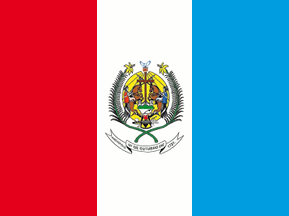 image by Dirk Schönberger, 29 April
2010
image by Dirk Schönberger, 29 April
2010
Last modified: 2012-02-11 by ian macdonald
Keywords: pirenópolis | goiás |
Links: FOTW homepage |
search |
disclaimer and copyright |
write us |
mirrors
 image by Dirk Schönberger, 29 April
2010
image by Dirk Schönberger, 29 April
2010
based on http://www.pirenopolis.go.gov.br/pirenopolis/simbolos.html
A vertical tricolor red-white-blue, with the municipal arms on the central stripe.
Municipal web site is at
http://www.pirenopolis.go.gov.br
Dirk Schönberger, 29 April 2010
The municipality of Pirenópolis (23,065 inhabitants in 2010; 2,228 sq. km) is
located in central Goiás, 120 km of Goiânia. Pirenópolis was founded in 1727
by the Portuguese gold miner Manoel Rodrigues Tomar as Minas de Nossa Senhora
do Rosário de Meia Ponte. Made a "vila" in 1832 and a "cidade" in 1853, it
was renamed Pirenópolis in 1890. The local legend says that the name of the
municipality was given by Spanish colonists coming from the Pyrenees
mountains. They also named the local mountain range Serra dos Pireneus.
Pirenópolis, once a rich town exporting gold and cotton, was known as the
Goiás Athens. It was the first town in the State with a library and a cinema.
The first newspaper in the Centro Oeste, "Matutina Meiapontense", was printed
in Pirenópolis by Commander Joaquim Alves de Oliveira, with Father Luís
Gonzaga de Camargo Fleury as its editor-in-chief. From 5 March 1830 to 24
May 1834, 526 issues of the newspaper reflected the ideas of the local elite.
Including, without any censorship, letters to the editor and satires, the "Matutina
Meiapontense" also served as the official gazette of the presidents of Goiás
and Mato Grosso. The town of Pirenópolis was registered as an historical
monument in 1989.
Lagolândia, a hamlet of Pirenópolis, is the birth
place of Benedita Cipriano Gomes (1905-1970), better known in Brazil as Santa
Dica. Aged 16 years, she miraculously "resurrected" following a cataleptic
crisis and became the "saint" of a messianic movement quickly banned by the
authorities. In 1925, Dica and her disciples were expelled from Lagolândia.
Portrayed by the painter Tarsila do Amaral, Dica also led a group of 150 men
who struggled in the Constitutionalist Revolution of 1932 and founded in São
Paulo the socialist utopia called "Angels' Town".
The coat of arms
of Pirenópolis is made of three layers. On the 1st layer, a "polliana"
(Allamanda
angustifolia Pohl, Family Apocynaceae) - a flower endemic of the Serra dos
Pireneus, the symbol of the local flora and the municipal flower, the riders
of the stampede (one Moor and one Christian), a mask, a "zabumba" drum, a
scroll inscribed "Pirenópolis 7 de outubro de 1727" [7 October 1727]. On the
2nd layer, the Holy Spirit, the Crown of the Emperor of the Feast of the Holy
Spirit, a "cruzeiro", the mother church of Nossa Senhora do Rosário, the
Pireneus, a mask and the bridge over river Almas. On the 3rd layer,
yellow, representing the blessing by the Holy Spirit.
Ivan Sache, 23 January 2012